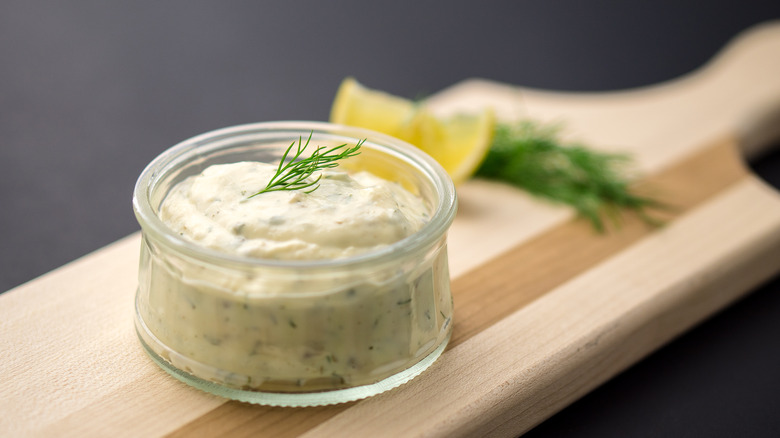How Ina Garten Adds A Touch Of Luxury To Tartar Sauce
Ina Garten, also known as the Barefoot Contessa, pays just as much attention to condiments as she does to main courses. Take Garten's fish and chips, which receive a luxurious upgrade not because of the fish itself but because of Garten's tartar sauce. In her recipe for homemade tartar sauce, shared by Food Network, Garten incorporates either champagne or white wine vinegar into her mixture. The addition of either lends itself to a well-rounded and well-balanced fish accompaniment.
In fact, many, if not most, tartar sauces incorporate some sort of vinegar, which adds tanginess and tartness. Champagne vinegar, however, also adds a specific flavor; it's mild and slightly floral, with a base of champagne's signature chardonnay grapes. Given its mellow nature, it's great alongside other ingredients, allowing them to shine. In a tartar sauce, champagne vinegar therefore plays the role of a supporting character, adding an acidic boost that's not too overpowering. White wine vinegar serves a similar purpose, with a relatively mild taste. Champagne vinegar, however, is slightly more dry.
It's up to you to choose between the two vinegars. Adding either form will result in a homemade tartar sauce that's brighter, fresher, and more flavorful than anything you'll find at the store, according to Garten. As for the ratios, you don't need a ton of either vinegar to complete your next dipping sauce.
Ina Garten adds a tablespoon of vinegar to balance tartar sauce
Fish and chips may be best washed down with a beer ... but that doesn't mean champagne — or at least champagne vinegar — lacks a place in your next fish and chips recipe. Ina Garten uses just a little bit of the bubbly-inspired vinegar, or its white wine counterpart, to enhance the flavor of her tartar sauce. Specifically, she mixes just one tablespoon into her recipe, which balances well with flavorful pickles and creamy mayonnaise, as well as capers, mustard, and seasonings.
Given the rationale for adding champagne or white wine vinegar to your next tartar sauce, you can apply this rule to your favorite recipes. Simply follow your tartar sauce recipe, and add in a tablespoon of champagne vinegar. Some recipes don't call for any vinegar but, instead, opt for other sour and acidic ingredients, such as lemons. If you're inclined to try one of Garten's suggested vinegars, consider swapping out that lemon for champagne or white wine vinegar to ensure a nicely balanced result. You want your tartar sauce to be creamy and slightly tangy, but not overwhelmingly so. After all, as Garten states, "You can't have fish and chips without tartar sauce."

